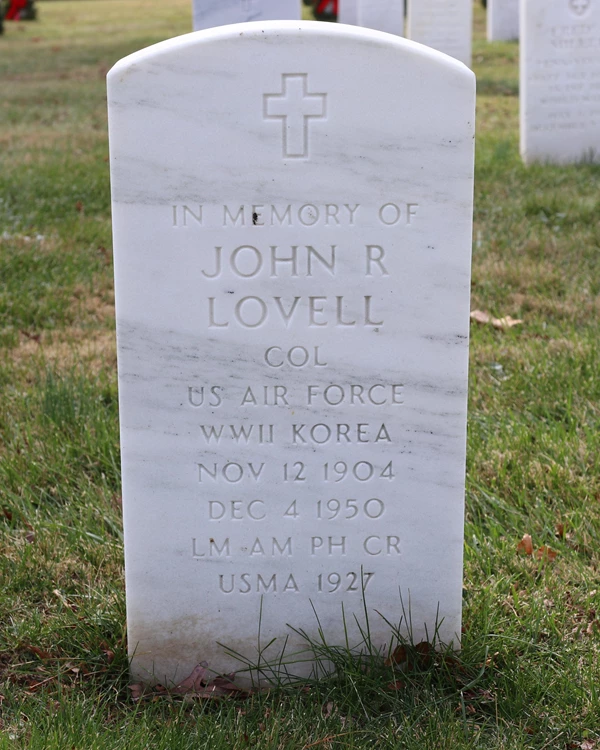Last updated: June 23, 2025
Person
John Lovell

NPS Photo
Section III, Row 7, Grave 21
Colonel John Lovell is the highest ranking U.S. intelligence officer to die during the Korean War. His story reminds us that not all who are remembered in Gettysburg National Cemetery were brought home for their final burial.
An Iowa native, was an experienced officer prior to the Korean War. He graduated from West Point in 1927, beginning his military career. He was a boxing referee at the 1936 Olympics in Berlin, and was a military attache in Berlin at the time of the attack on Pearl Harbor. During WWII he served with the Coastal Artillery Corps, but by the war’s end he was working in US intelligence. By 1950, he was the director of intelligence for the US Air Force.
As a high-ranking intelligence official, Lovell was initially stationed stateside at the Pentagon, but by late 1950, that changed. On Thanksgiving Day, Nov 23, 1950, his daughter Nancy recalled her father packing his bags, as he was going on temporary assignment to the 5th Air Force.
Despite his high-ranking position, on December 4, 1950, Jack was aboard a RB-45 Tornado jet on a reconnaissance flight near the Yalu River, the boundary between North Korea and China. The men took off from Yokota Air Base around lunchtime that day, flying into blue skies never to return.
It is not officially known why he was aboard such a secretive flight. Lovell was likely overseeing the use of RB-45s for spying during the war and wanted to be on board for a flight to see first hand the risks that crews were taking by piloting such planes into Chinese and possibly Soviet air space. Howard Barkley, who served with Lovell in intelligence during WWII, said this of his comrade:“He was a leader, and the qualities of leadership require sometimes taking risks.”
Lovell’s plane was likely doing reconnaissance in response to the massive Chinese offensive into Korea and the on-going battle at Chosin. Their flight was top secret, and is not mentioned in any official air force histories of the Korean War. There are only two recorded instances of this plane being used in reconnaissance during the war—this instance would make three.
On his flight that day, Jack’s RB-45 Tornado plane was shot down by Soviet Migs some 45 miles east of Andung, China, just across the Yalu from Sinuiju, North Korea. Two crew members—co-pilot Capt. Jules E. Young, 29, of East Rochester, N.Y., and 1st Lt. James J. Picucci, 32, of New York City, the navigator—were likely killed in the crash.
A soviet report indicated seeing one parachute emerge from the aircraft, belonging to the pilot, Captain Charles McDonough, who managed to survive the attack and was subsequently captured behind enemy lines.
Another pilot, Hamilton Shaw, recalled seeing McDonough at a prison in North Korea. He last saw him being taken away in an Ox cart and noted he was in rough shape. McDonough had spent several days evading capture, suffered severe frostbite, and sought shelter from a family home in North Korea, only for them to turn him over to Communist forces. After being in captivity for two weeks, Charles died on Dec 18, and his interrogation was never finished.
For John Lovell, his fate is uncertain. It is likely that he died in the plane crash, though in May 1951, Lovell’s name was picked up by US intelligence in an “enemy broadcast” in China, suggesting he had been captured. In 1953, his name was listed as one of 71 Americans still in Communist captivity after the final prisoner exchange in September.
In 1954, the US government declared Colonel Lovell was dead. In John's honor, his family chose to have a memory stone placed here in Gettysburg National Cemetery. When his wife Norma passed away in 2000, she was buried next to John’s memory stone in Section 3.
